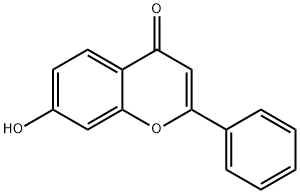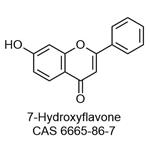Synthesis
Acetylation of resorcinol acetic acid yields 2,4-dihydroxyacetophenone, which is then subjected to benzoylation and transposition to obtain (2-hydroxy-4-benzoyloxy)benzoylacetophenone. 7-hydroxyflavone was obtained by further cyclization reaction in a mixture of acetic acid and hydrochloric acid at 103° C for 7 h.
Chemical Properties
off-white crystals
Uses
antifungal, analgesic
Uses
Reactant:
- Acting as a biologically valuable acceptor in O-glycosidation reactions
- Involved in synthesis of fully phosphorylated flavones for use as pancreatic cholesterol esterase inhibitors
- For O-methylation with di-Me carbonate
- Linked by a polymethylene chain for synthesis of α1-adrenoceptor antagonists
- Involved in Baylis-Hillman reactions
- Involved in phase-transfer catalyzed glucosylation for synthesis of glucosylated flavonoids
Definition
ChEBI: 7-hydroxyflavone is a hydroxyflavonoid in which the flavone nucleus is substituted at position 7 by a hydroxy group.
Biological Activity
7-Hydroxyflavone is a flavonoid isolated from M. indica with anti-inflammatory properties. It protects renal cells from nicotine (NIC)-induced cytotoxicity through the ERK/Nrf2/HO-1 pathway.



